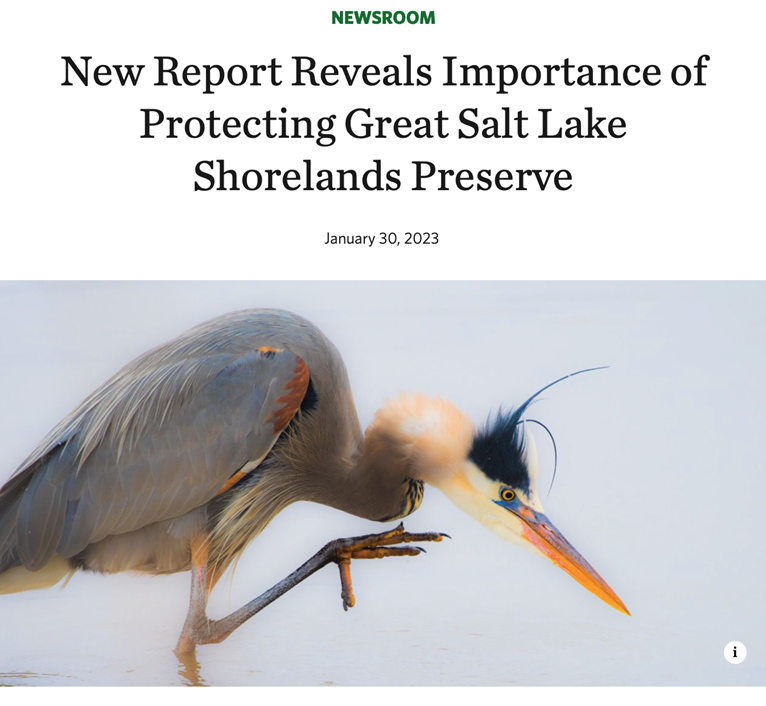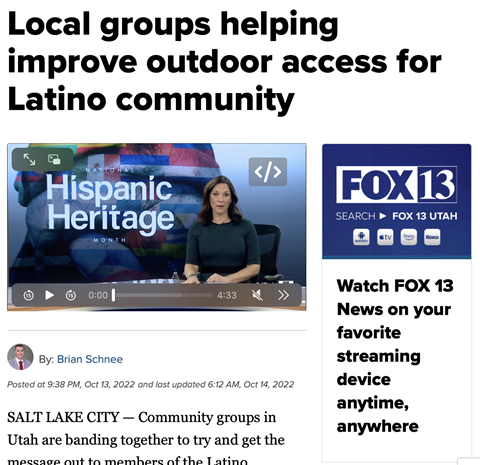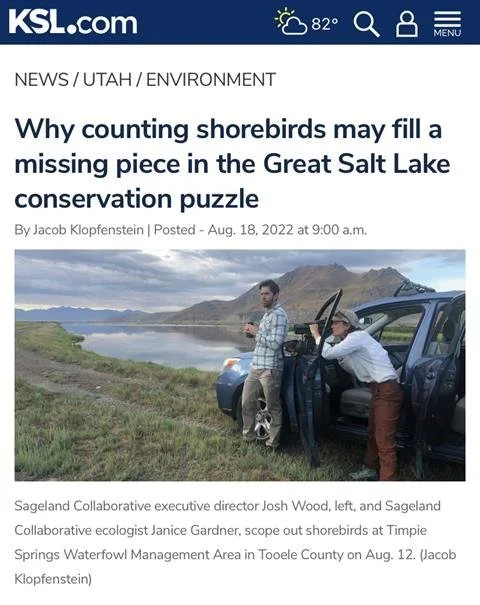Exploring by the Seat of Your Pants brings science, exploration, conservation and adventure live into classrooms around the world through virtual guest speakers and field trips. Join Rose Smith, Sageland Collaborative’s Stream Ecologist, as she presents about the role of beavers in conservation in this recorded livestream!
Read MoreSageland Collaborative is proud to foster high school, college, and university students into the natural resources field through hands-on volunteer opportunities! Auriana Dunn with Wasatch Magazine highlights some of the many ways that students can “collect them all” by participating in our community science programs.
Read MoreSageland Collaborative and The Nature Conservancy are looking for volunteers to help plant native plants at the Great Salt Lake Shorelands Preserve this Friday.
Read MoreUtah is joining communities across the country this weekend in celebrating Latino Conservation Week, with events aimed at connecting culture and nature. Sageland Collaborative, along with a range of community partners, is leading the celebrations. Community outreach coordinator Frances Cabrera Ngo said the events are designed to create inclusive spaces for the Latino community to enjoy the outdoors.
Read MoreConversations around the restoration of Great Salt Lake often focus on water–but what’s happening with the ecosystem of the shoreline itself?
Read MoreIf you’ve ever wondered what it’s like to be a beaver–wonder no more! Beginning August 29th, Sageland Collaborative kicks off our Riverscape Restoration season in streams and creeks across northern Utah.
Read MoreYou don’t have to travel far to meet wild neighbors in Salt Lake City. For over seven years, Sageland Collaborative and University of Utah’s Wasatch Wildlife Watch program has captured glimpses of our elusive wildlife neighbors via a network of trail cameras dotted throughout the Wasatch.
Read MoreOur Executive Director, Janice Gardner, spoke with Fox 13 News about how federal funding changes are impacting our stream and river restoration projects across the Great Salt Lake and Weber River watersheds. Despite the setbacks, we remain committed to healing degraded streams and engaging our community in conservation projects.
Read More“On October 22, 2022, it was another mundane, quarterly gathering of technical experts and brine shrimp harvesters reporting data on Great Salt Lake. Yet, in the middle of the meeting, I found myself — a biologist who has worked with the lake for 15 years — escaping from the conference room to cry in the bathroom.”
Read MoreOur team works passionately on multiple issues tied to Great Salt Lake. From riverscape restoration to our Migratory Shorebird Survey in Utah, our team cares deeply about the lake and communities who depend on it--from shorebirds to humans.
Check out The Nature Conservancy's recent article highlighting the work of Sageland Collaborative staff. Findings include bird activity as potentially linked to the shrinking lake.
Read MoreWe've been talking a lot about beavers, and we're not alone! CBS Mornings shared this story, which features our stream restoration site where we recently released beavers with our partners.
Read MoreA huge thank you to the amazing group of volunteers at our recent Conservación de Castor event.
Thank you as well to our partners at GreenLatinos, Tracy Aviary, Latinos In Action, Arts de Mexico en Utah, Utah Division of Wildlife Resources, and Salt Lake County Parks and Recreation who made this possible. Read the full Fox13 story here.
The health of the shrinking Great Salt Lake is "a matter of life and death for migratory shorebirds," according to Janice Gardner, Sageland ecologist quoted in a recent KSL article. "However, with the lake's water level dropping to historic lows two years in a row," the article continues, "shorebirds are slowly losing critical habitat."
Read MoreAs climate change, drought, and questions about water allocation converge in the West, scientists like stream ecologist Rose Smith work to find meaningful solutions. What kinds of issues can stream restoration help support? Read this recent Fox 13 article to learn what scientists are saying.
Read MoreWe're excited that Utah Public Radio recently hosted Wasatch Wildlife Watch project lead Austin Green. Austin discusses a recent study based on the project, all about how human influence is altering the behavior of several species in northern Utah. Listen to the story here.
Read the paper, published in Conservation Science and Practice, to learn more about effects of human development, environmental factors, and a highway on our Wasatch wildlife. This information is crucial to successful conservation and mindful development. And it's all thanks to our amazing Wasatch Wildlife Volunteers and donors, project leads Austin Green and Mary Pendergast, and our many partners. Thank you!
Read MoreHigh in the snow-covered mountains of Northern Utah, Kim Savides, a graduate student in the Department of Wildland Resources at Utah State University waits for the daily avalanche report during winter months. If favorable, she ventures out to remote bird feeders in hopes of finding black rosy-finches.
The finches thrive in bad weather. When it’s a clear, sunny day Savides knows her likelihood of seeing a finch is slim. But on nasty, snowy, windy days she can count on seeing hundreds of the finches around the feeders…
Read MoreWhat Glen Canyon once was, is slowly starting to come back. At Lake Powell’s high water mark, which hasn’t been under water in over 20 years, dozens of plants, insects and wildlife have been gradually settling back in.
“Because of continued demand for water, for Colorado River water, and climate change as well, we’ve had a two-decade-long shortage on the river system,” Eric Balken, director of the Glen Canyon institute explained. “These canyons that were once filled by the reservoir, they’re now out of water, and there’s a big question as to how those canyons are restoring.”
Read MoreDuring the first half of the show, Nell and Chris learned about the Wasatch Wildlife Watch, a massive citizen science effort using camera traps to gather data about wildlife in the Wasatch Front and how they are impacted by humans. Dr. Mary Pendergast from Wild Utah Project, and Austin Green with the University of Utah joined Chris and Nell to share the details and how listeners can get involved as volunteers.
Read MoreOutdoor recreation and wildlife cohabit in a big way along the Central Wasatch Mountains and the foothills that tumble into Utah’s largest urban area, yet scientists have only a vague idea of how animals respond to all the athletes, picnickers and hikers traipsing through their living room.
Now biologist Austin Green hopes to find firm answers using dozens of trap cameras. But his research has generated more information than he and his team can handle: 50,000 critter images recorded during a 105-day study period last spring and summer.
Read MoreThere has perhaps not been a more important time to hone our understanding of the current state of ecological health and function of the Wasatch Mountains and the wildlife that live here.
The Wasatch sustains 9 million visitors a year, which is about the same as that of the “mighty five” Utah national parks. Currently many planning processes and opportunities to shape the future of the central Wasatch are unfolding, ranging from the Central Wasatch National Conservation and Recreation Area legislation, transportation solutions from the recent blue print of the Central Wasatch Mountain Accord, and other national forest planning opportunities.
Read More



















